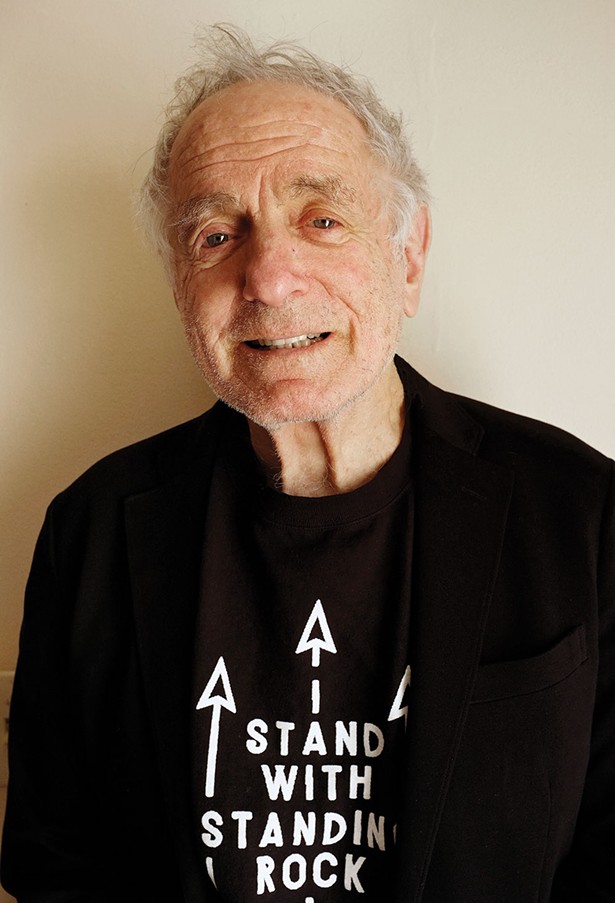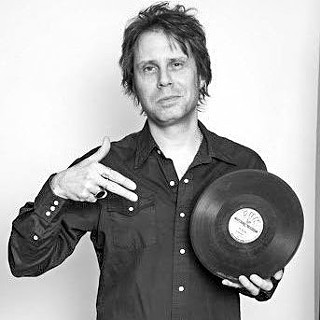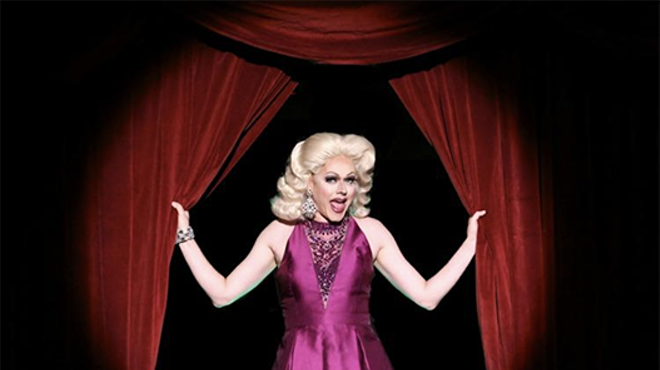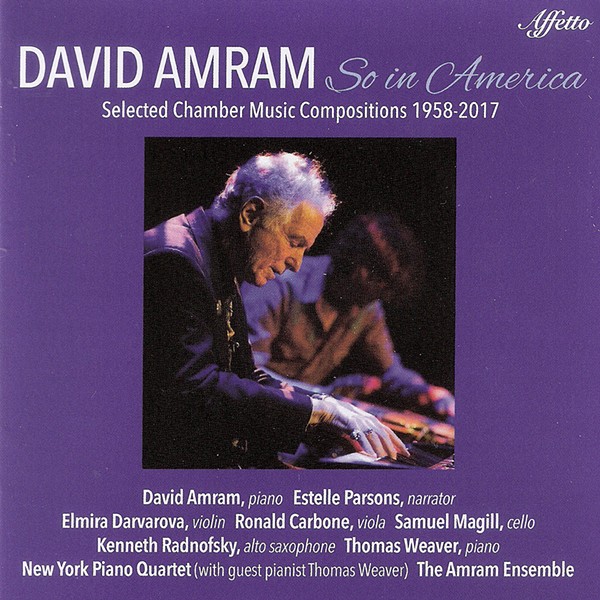David Amram shares stories of his career ahead of his new album release on March 2.
Outside, the Beacon condominium blends right into the rest of the complex. It's one indistinguishable segment of a white, multi-unit box. But inside it's something unexpected: not the big-screen-and-a-Barcalounger end spot of a downsized retiree.
Every inch of flat surface is given over to the tools, the raw material, the reminders, and the products and byproducts of a constantly creative state of existence. Tabletops, desks, dressers, and bookshelves tower and overflow with stacks of lead sheets, paper-packed manila folders, books, and CDs. A woodcut sits side-by-side with a sleek MacBook; a primitive wooden flute lays perched atop a modern electronic keyboard. It's as if the walls of this place—randomly decorated with framed and unframed photos, award certificates, and concert posters—are all that's keeping this entropic extension of what's clearly an inventive mind from exploding into the world outside.
But in the end mere walls, be they metaphorical, artistic, or, yes, physical, can't contain the genius of the resident, David Amram. At 87, the inspirational polymath cited as "the Renaissance man of American music" continues to remind us of that wonderful fact.
"When I was a little kid, it was hard to explain to people what my dad did because he was always doing so many different things," says his daughter Alana Amram. "The other kids in school would say, 'My dad's a carpenter' or 'My dad's a doctor,' but I wasn't sure what to say. So I asked him and he went into this typically long, deep explanation: [adopts deep voice] 'Well, you can say I'm a composer, multi-instrumentalist, conductor, yada, yada, yada...' And I was, like, 'Dad! Can I just say musician?!'"
Fair enough. But, then again, for this writer of over 100 orchestral and chamber works; scorer of feature films, Broadway productions, and operas; and collaborator of such icons as Jack Kerouac, Arthur Miller, Dizzy Gillespie, Bob Dylan, Charlie Parker, Jackson Pollock, Leonard Bernstein, Charles Mingus, Langston Hughes, Pete Seeger, Franz Kline, Eugene Ormandy, Willie Nelson, Hunter S. Thompson, and Thelonius Monk, to "just say musician" would also mean leaving out many other titles. Like author, narrator, actor, and...farmer.
"It was wonderful," says Amram, who was born in New York in 1930, about growing up on his family's dairy farm in Feasterville, Pennsylvania. "At that time, the population in Feasterville was about 200. I actually learned a lot about the discipline of playing an instrument from being on the farm. The cows have to be milked, even when you might not feel like doing it, and it's the same with practicing: You might not feel like doing it sometimes, but you still have to do it if you want to be good."
There was music around Feasterville, mainly folk styles, it being a rural area. "My parents knew a lot of older local folk artists; I met Pete Seeger at a Henry Wallace rally in 1948 and I was just fascinated by the banjo," he recalls about his future Beacon neighbor. "There was also a lot of traditional Jewish music in my family, and I had some uncles from Las Vegas who exposed me to Native American music. At one point we lived in an area where there was a lot Polish music and "cowboy music," or what we now call country music. Folk music has what I also love about jazz: the spontaneity."
Although he loved music, initially he'd planned to follow his father into the field of agriculture. The elder Amram, who would soon take the family off the farm due to hard times, though, wasn't having it. "My dad asked me what I wanted to be, and I told him I wanted to be a farmer," says Amram. "He said, 'Well, son, there's no money it.' So I told him, 'Well, then I want to be a musician.' And he said, 'There's no money in that, either!' [Laughs.]"
Nevertheless, Amram's parents sensed the promise in his musical passion and nurtured it, especially after the nascent French hornist, at 14, met and was encouraged by New York Philharmonic conductor Dimitri Mitropoulis. He attended Oberlin College Conservatory in 1948 but ended up pursuing a degree in history at George Washington University, graduating in 1952. While in Washington, DC, he performed with the National Symphony Orchestra and the Latin jazz band of drummer Buddy Rowell, and hosted jam sessions and post-gig parties in his basement apartment that were attended by bebop greats Charlie Parker and Dizzy Gillespie.
Like Mitropoulis had, Parker—"Bird," as the saxophonist was known to bop fans—took Amram under his wing. "His music made me aware that every sound is related to every other sound," writes Amram in his 1968 memoir, Vibrations. "He was like an architect and a painter and a poet all at the same time. His attitude of an open mind and an open heart, of playing with anybody, listening to everything, trying to appreciate everything and then being able to distill all these experiences in his own way—all this affected me and a whole generation of people who were aware enough to get the message." Gillespie's forays into Pan-African music with Cuban percussionist Chano Pozo, as well as the general international climate of DC, also impacted Amram's eventual work as a world-music pioneer.
After a stint in the Army that saw him stationed near Paris and recording with Lionel Hampton, Amram landed in New York, where his uncommon choice of French horn as his first instrument helped him stand out in the crowded Gotham jazz scene. He performed with Charles Mingus's Jazz Workshop and bassist Oscar Pettiford, co-led a quartet with saxophonist George Barrow, and led his own bands. One of the regular attendees at his gigs was Jack Kerouac. "He used to come hear me at the Five Spot," Amram remembers. "We bumped into each other at a BYOB party and, besides knowing we both liked jazz and literature, learned that we both spoke French. Jack knew some French folk songs and sang them for me."
Their shared enthusiasm for music and words and wide-eyed worldview saw the pair become fast friends, bringing Amram into Kerouac's circle of fellow Greenwich Village poets and writers—the architects of the Beat movement. In December 1957, at the Brata Gallery on East 10th Street, Amram accompanied Kerouac at the first jazz-poetry reading in New York, which was followed a few months later with similar events elsewhere. "Sometimes he'd sing while I was playing the horn, improvise verses," Amram says. "He had a phenomenal ear. It was like playing duets with a great musician." Kerouac and Amram starred alongside poets Allen Ginsberg, Gregory Corso, and Peter Orlvosky, artist Larry Rivers, and others in Robert Frank and Alfred Leslie's landmark 1959 experimental film Pull My Daisy and cowrote its surreal theme song. "Jack was open, enthusiastic, and kind," says Amram, who collaborated with the On the Road novelist for over 12 years. "The whole 'Beatnik' thing got big and people saw it as this gravy train they could jump on. Jack was the engine that pulled that train, and he didn't dig it at all. He was never in it to be tabloid trash."
While he was working with the reluctant bard of the Beats, Amram was, indirectly, also working with the Bard: From 1956 to 1967 he composed the scores for Joseph Papp's newly launched Shakespeare in the Park series (in 1968, Papp penned the libretto and Amram composed the music for an operatic adaptation of Shakespeare's comedy Twelfth Night). His music for Elia Kazan's 1958 production of Archibald MacLeish's play "J.B." won a Pulitzer Prize, and further fame came when he scored the hit movies Splendor in the Grass (1961) and The Manchurian Candidate (1962); Arthur Miller's play "After the Fall" (1964; during his stint as Lincoln Center Theater's composer and music director); and TV's The Final Ingredient: An Opera of the Holocaust (1965). In 1966, Leonard Bernstein appointed him as the New York Philharmonic's first composer-in -residence. In Manhattan, it seemed, the Feasterville farm boy had found his fertile row.
But instead of joining the Hollywood or Broadway establishments, he remained a restless artistic explorer, especially of the music and customs of other cultures. His mesmerizing 1971 double album No More Walls crosses jazz, classical, and South American, Middle Eastern, and Afro-Cuban music but found few takers upon its initial release. "People didn't get it," says Amram, a deep student of Native American music who has adapted those indigenous styles for classical chamber works. "It was too way out for the classical audience, and for the avant-garde jazz audience it wasn't the set-the-piano-on-fire stuff they were looking for." In time, though, the album would come to be seen a cornerstone of world-fusion music.
Amram's next major culture-spanning effort came in 1977, when a contingent including him, Dizzy Gillespie, Earl "Fatha" Hines, Stan Getz, and other top jazzmen sailed to Havana to be among the first legally visiting US citizens in Cuba in 16 years and to perform with local musicians. The resulting album, Havana/New York, features trumpeter Arturo Sandoval and alto saxophonist Paquito D'Rivera of the legendary band Irakere. "At first nobody [among the American musicians] knew what the protocol was or how we should act around the Cuban players," says Amram. "But that all went away really quickly. Being stuck, politically, between the US and Russia was hard on them. We learned that they appreciated a lot of things about American culture more than we did!" Last month, nearly 41 years after the milestone concert, Amram returned to Cuba to perform at the Havana International Jazz Festival.
Throughout the remainder of the 1970s and into the '80s and '90s came more concerts, tours, commissions albums, theatrical scores, soundtracks, and perhaps his greatest creation of all: the three children he raised with his ex-wife. The period also saw a lengthy return to agrarianism with the stewardship of Peekskill Hollow Farm in Putnam Valley, where his family grew organic vegetables and kept Jersey cows until the kids flew the nest and it became too much for even the multitasking maestro to manage. Today, Alana is a solo singer-songwriter and the bassist of Los Angeles garage punks Death Valley Girls and her younger siblings are musical performers as well: Adam is the drummer of New York psychedelic band Psychic Ills and Adira has worked with DJ Kid Koala.
The 2000s, however, may be the purplest patch yet for the octogenarian. His most recent opuses include 2002's Giants of the Night, 2007's This Land: Symphonic Variations on a Song by Woody Guthrie, and 2009's Three Songs: A Concerto for Piano and Orchestra. As he looks forward to the next 80 years, does Amram have any plans to at last take some time off?
"I'll have to check with my girlfriend, she runs the schedule on my website," the author of three books, former amateur boxer, and recent star of the Actors Studio's production of Chekov's "Uncle Vanya" says with a laugh. "Whenever I try to not do anything, I slide right back into doing something else. Someone recently asked me if was thinking of making a comeback—I said, 'Man, I make three or four comebacks a week!'"
David Amram's So in America: Selected Chamber Music Compositions 1958-2017 is out March 2 on Affetto/Naxos Records.














